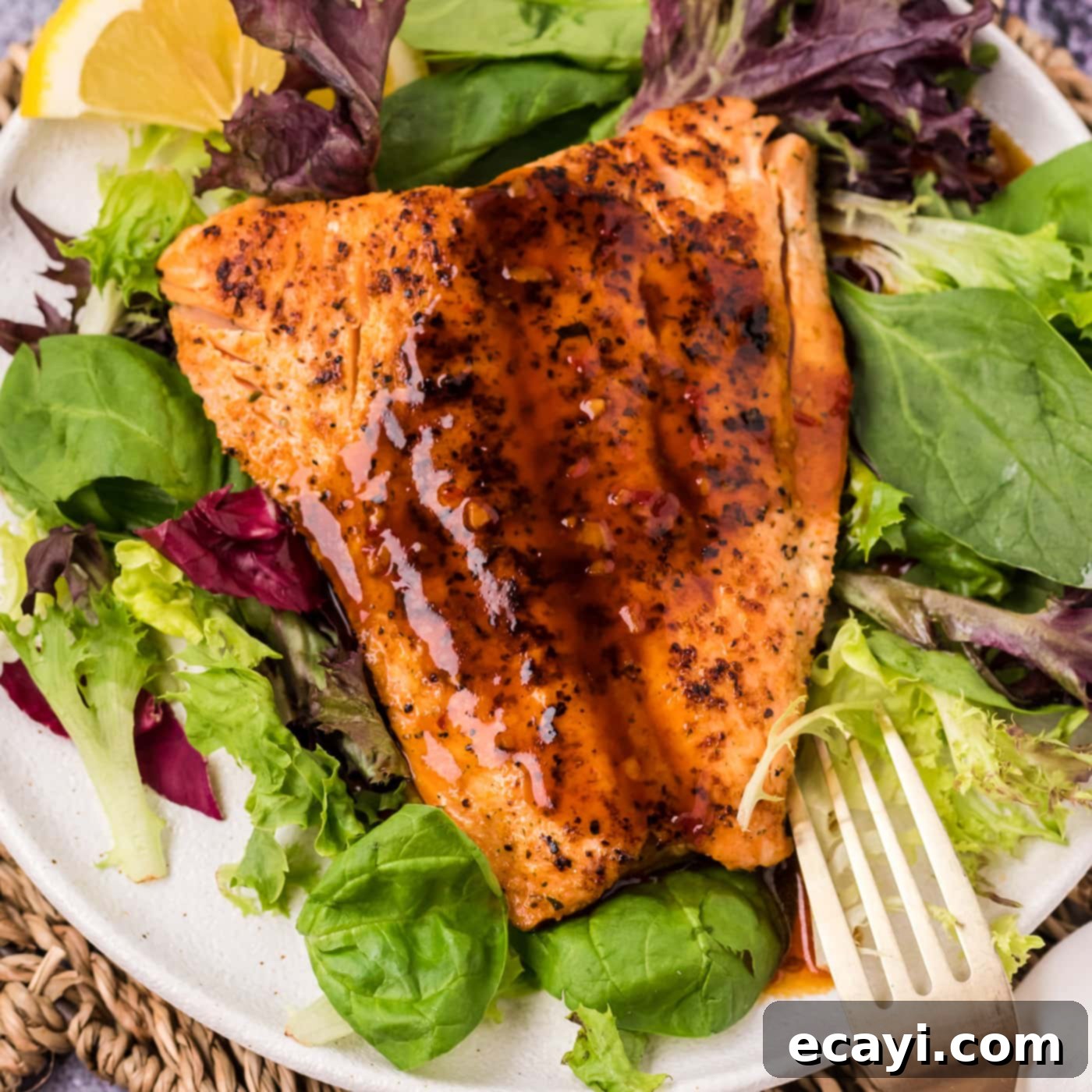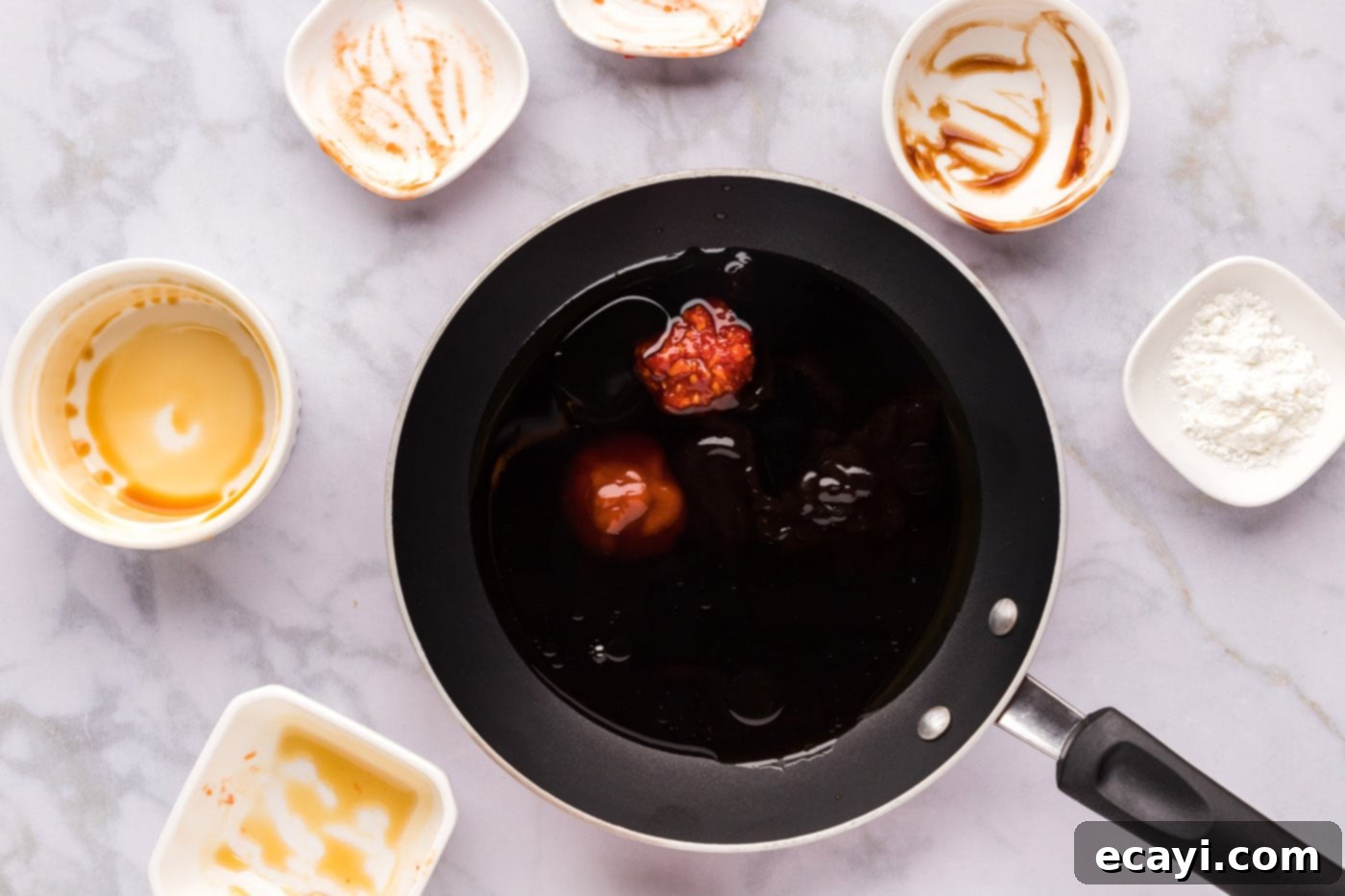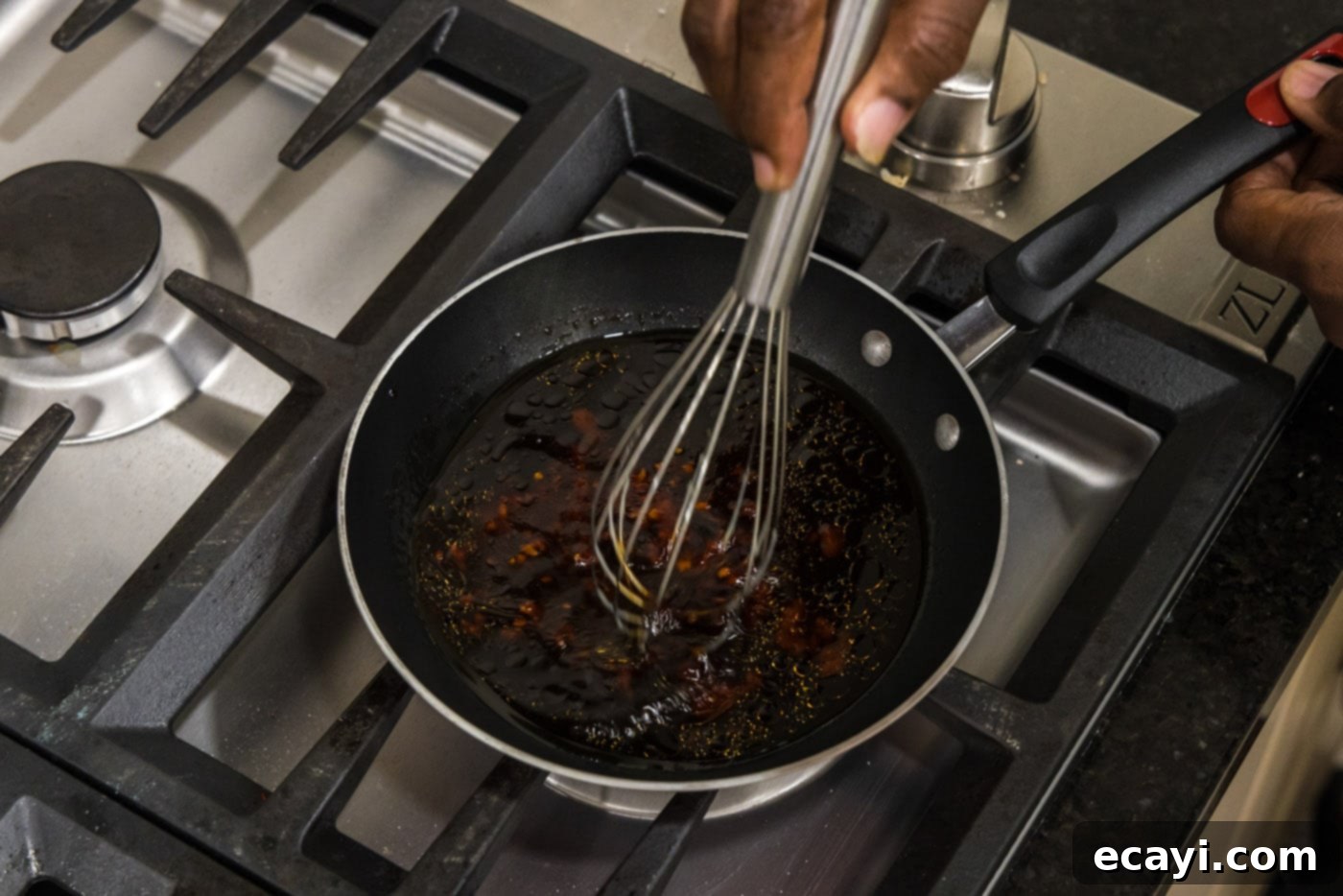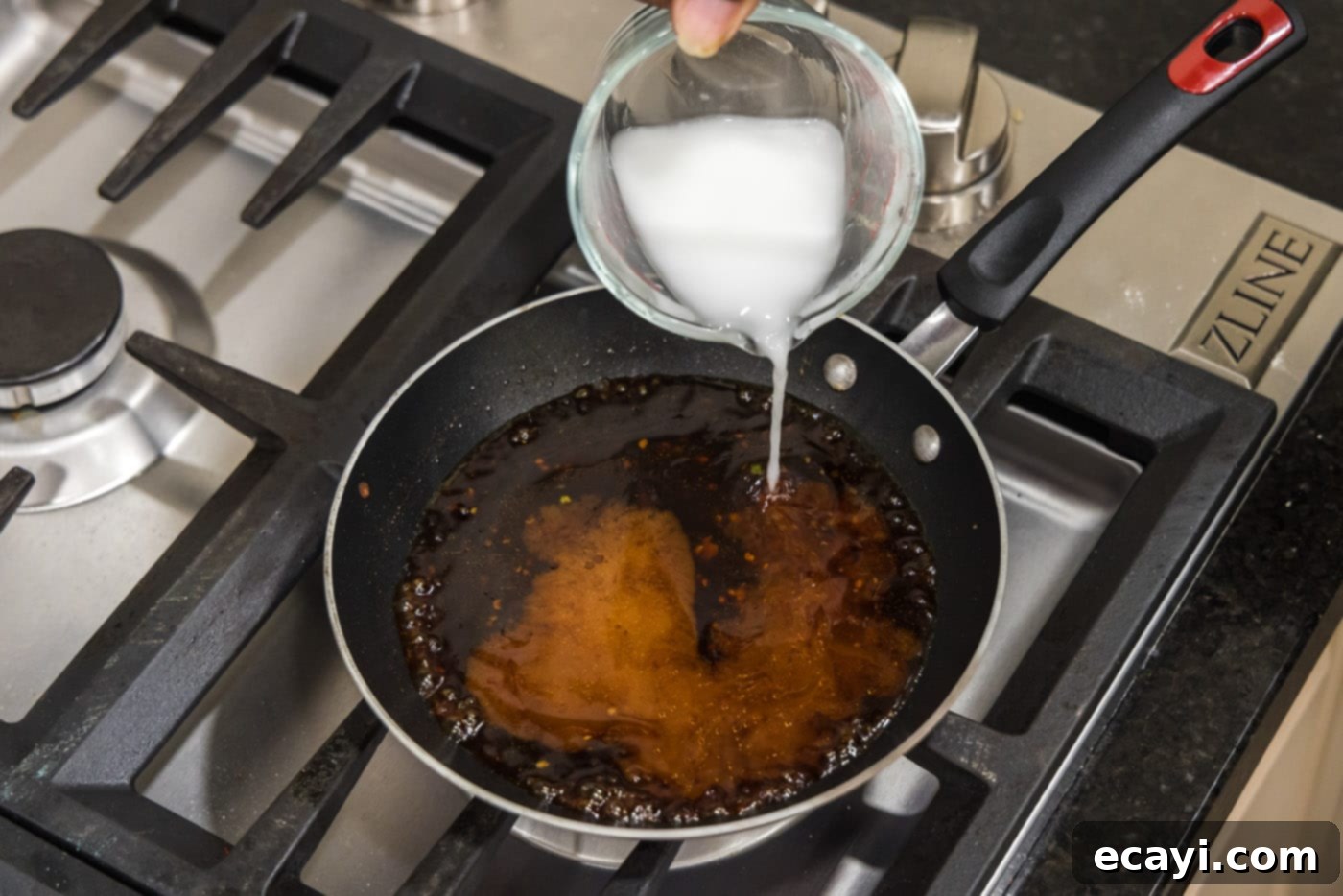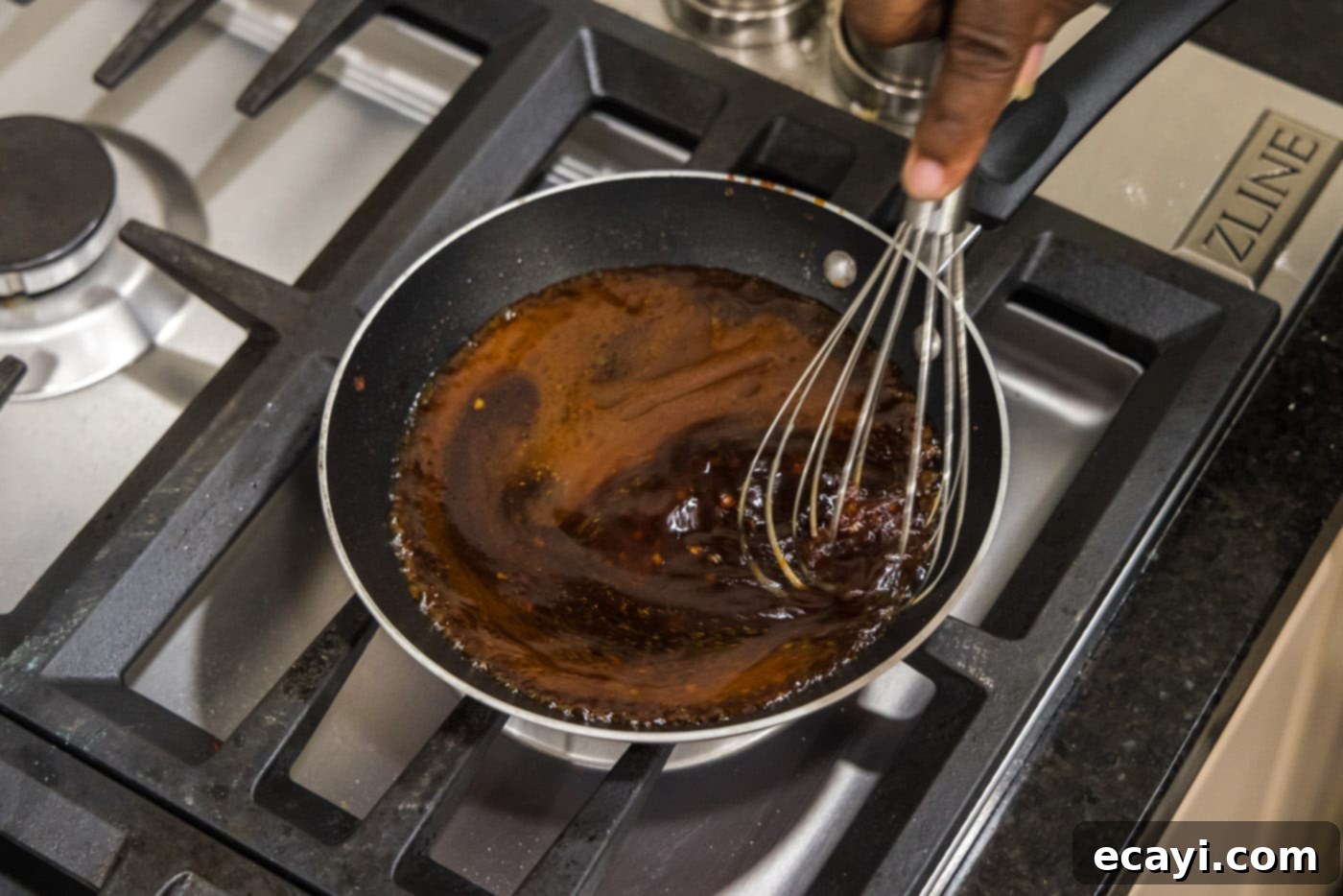Irresistible Sweet & Spicy Salmon Sauce: Your New Favorite Asian-Inspired Glaze
Elevate your weeknight salmon dinner from ordinary to extraordinary with this deeply flavorful, sweet and spicy salmon sauce! Crafted with a harmonious blend of soy sauce, hoisin sauce, Asian chili sauce, sriracha, and a touch of maple syrup, this incredible glaze balances a symphony of savory, sweet, and fiery notes. It’s the perfect companion for transforming your delicate, flaky salmon fillets into a culinary masterpiece, ensuring every bite is bursting with an unforgettable taste experience. Get ready to impress your taste buds with this easy-to-make, versatile sauce that’s sure to become a staple in your kitchen.
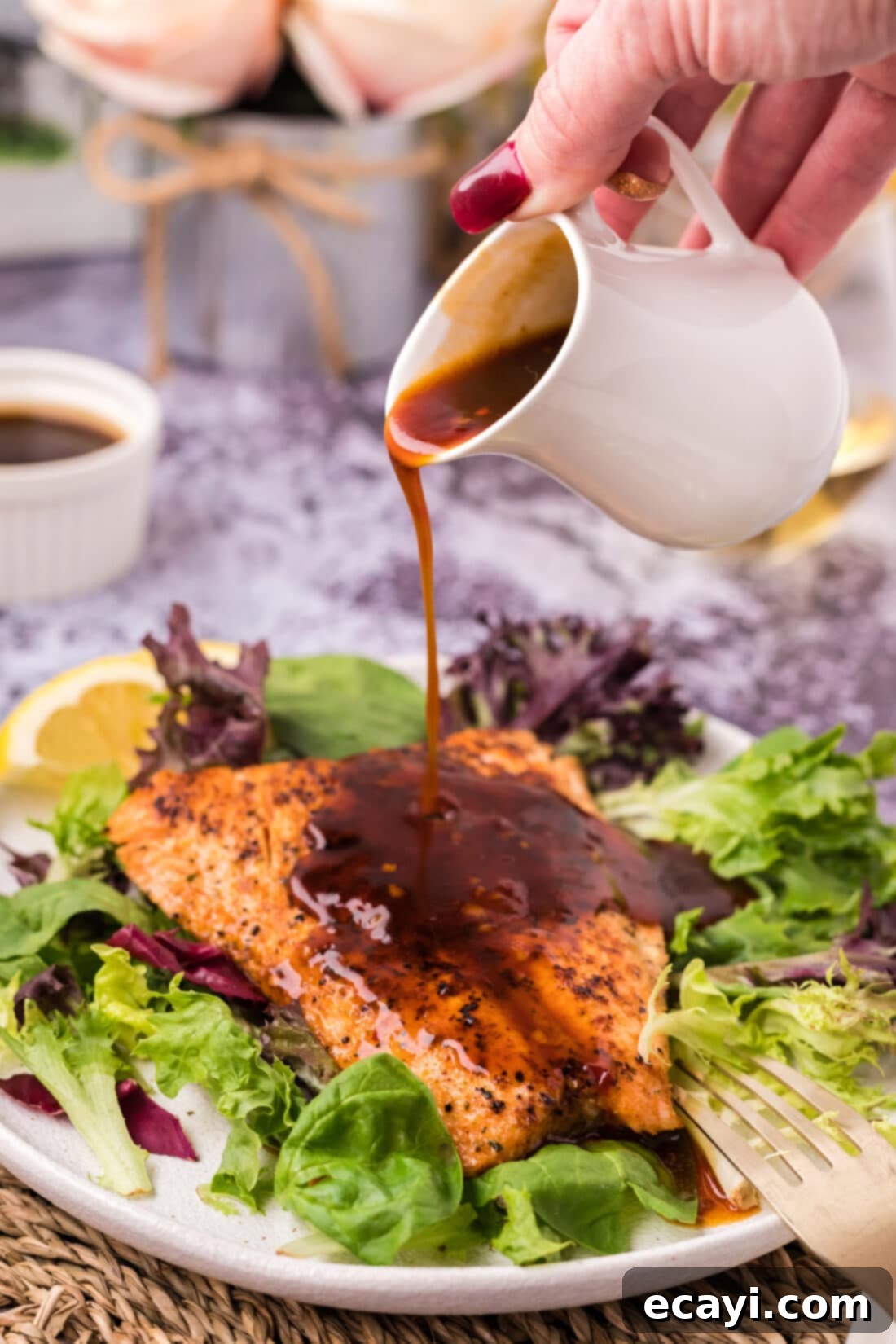
Why This Sweet & Spicy Salmon Sauce Recipe Works Wonders
While a classic lemon cream sauce, like the one used in our popular baked salmon recipe, offers a delightful tang, sometimes you crave something with a bit more zing and complexity. This sweet and spicy salmon sauce is precisely that game-changer. It introduces a vibrant kick and a rich, multi-layered flavor profile that perfectly complements the natural richness of salmon. If you’re a fan of flavors that dance on your tongue and leave a memorable impression, this recipe is designed for you.
The magic of this sauce lies in its masterful balance. We’ve meticulously combined the deep umami and saltiness of soy and hoisin sauces with the invigorating heat from Asian chili sauce and sriracha. This savory-spicy foundation is then beautifully mellowed and rounded out by the natural sweetness of maple syrup, creating a truly mouth-watering and addictive glaze. This carefully calibrated blend doesn’t just add flavor; it truly elevates salmon, transforming a simple fish dish into an exciting, restaurant-quality meal. It’s quick to prepare, using common pantry staples, and offers incredible versatility, making it an ideal choice for busy weeknights or when entertaining guests.
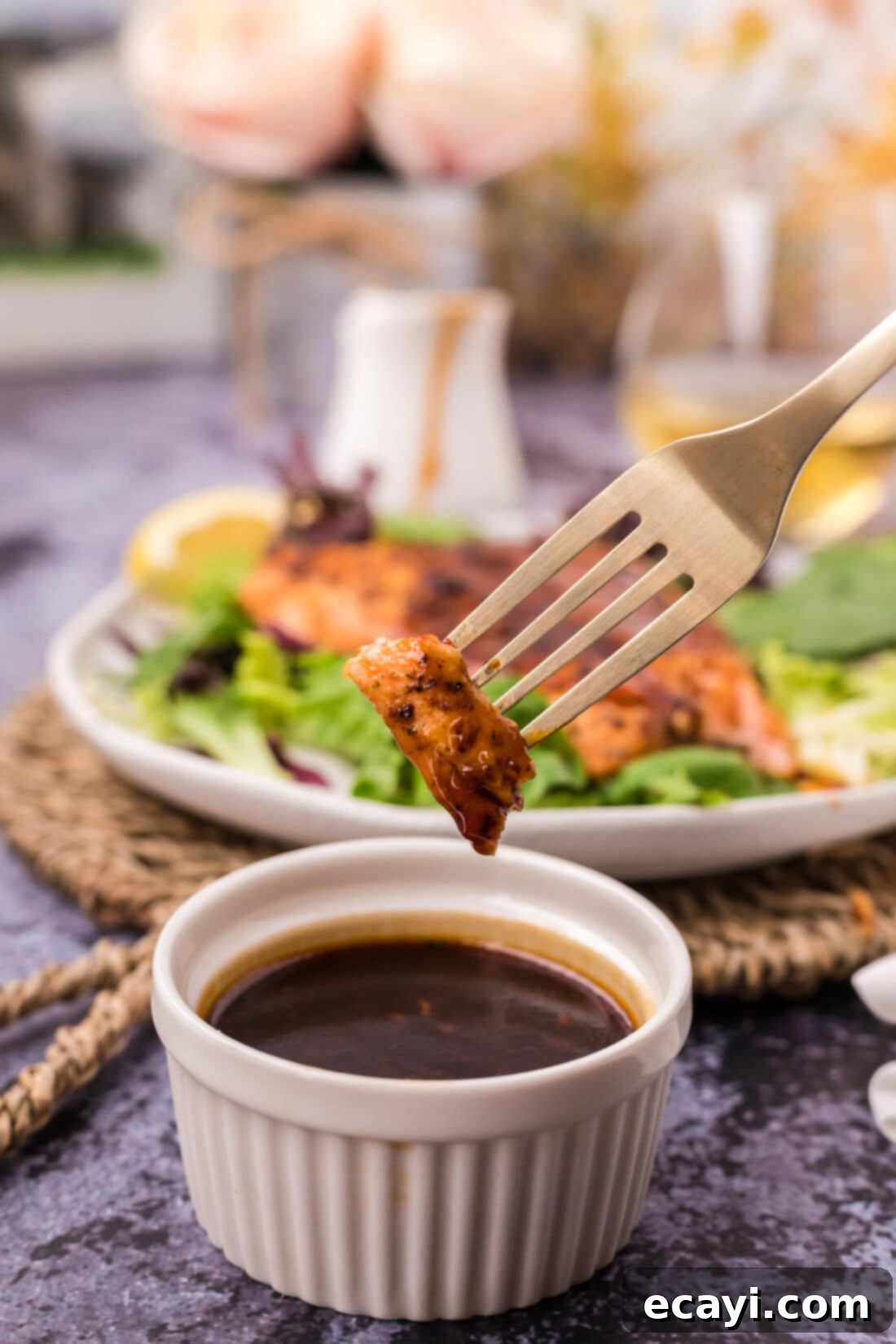
The Allure of Salmon and the Perfect Sauce Pairing
Salmon is renowned for its heart-healthy omega-3 fatty acids, high protein content, and rich, distinctive flavor. Its firm, flaky texture makes it incredibly versatile, suitable for various cooking methods from baking and grilling to poaching and pan-searing. However, even the finest salmon can benefit from a complementary sauce that enhances its natural attributes without overpowering them. This sweet and spicy glaze does just that. It adds moisture, depth, and an exciting contrast of flavors that makes each bite more engaging. The subtle sweetness helps caramelize the exterior of the fish, while the chili adds an invigorating warmth that awakens the palate. It’s not just a sauce; it’s an integral part of the salmon experience.
Key Ingredients for Your Delicious Salmon Sauce
Crafting this incredible sauce requires just a handful of readily available ingredients, ensuring you can whip it up anytime a craving strikes. You’ll find all precise measurements, ingredient details, and comprehensive instructions in the printable recipe card located at the end of this post.
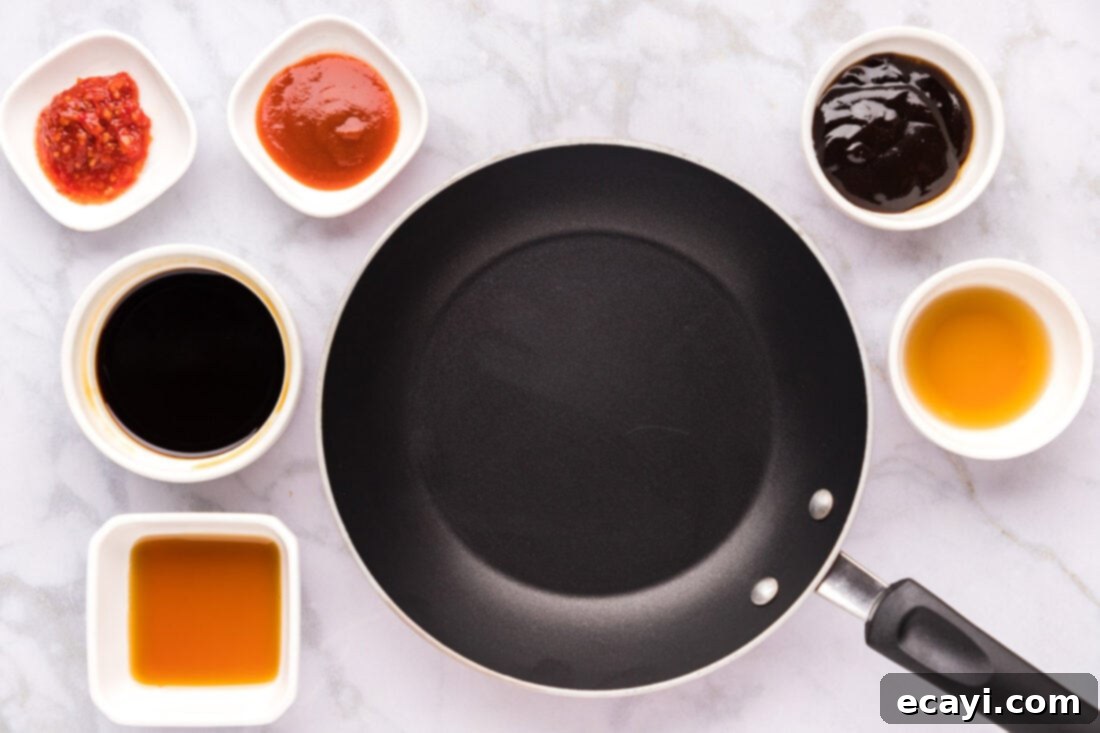
Ingredient Spotlight & Smart Substitutions
Understanding each ingredient’s role allows you to customize the sauce to your preference and make smart substitutions when needed:
- Soy Sauce: This recipe specifically calls for low-sodium soy sauce. This is crucial for controlling the overall saltiness of the sauce, especially when combining it with other savory ingredients like hoisin. If you opt for regular soy sauce, be aware that your final product might be noticeably saltier. If using regular, consider reducing the amount slightly and tasting before adding the full quantity. For a gluten-free option, Tamari is an excellent substitute that delivers a similar savory depth.
- Hoisin Sauce: A thick, fragrant sauce often used in Chinese cuisine, hoisin contributes a distinct sweet, salty, and tangy flavor with hints of spices like fennel and star anise. It adds incredible depth and a beautiful gloss to the sauce. There isn’t a direct single-ingredient substitute, but if you’re in a pinch, a mix of soy sauce, honey or brown sugar, a dash of rice vinegar, and a tiny bit of garlic powder can mimic some of its characteristics, though the complexity will be reduced.
- Asian Chili Sauce & Sriracha: These are the dynamic duo responsible for the sauce’s delightful heat. Asian chili sauce (often labeled Sambal Oelek) provides a fresh, bright chili flavor, while sriracha adds a garlicky, fermented chili kick. The combination creates a balanced and invigorating spice.
- For additional heat: If you love a fiery kick, feel free to incorporate some crushed red pepper flakes or a few drops of pure chili oil into the mix. Taste as you go to avoid overwhelming the other flavors.
- To reduce heat: You can slightly decrease the amount of both chili sauces. Start with half the recommended amount and increase if you dare!
- Maple Syrup: This natural sweetener provides the perfect counterpoint to the savory and spicy elements, bringing balance and a subtle caramel note.
- Substitution: You can easily substitute maple syrup with honey, which offers a similar sweetness and viscosity. Brown sugar or agave nectar could also work, though they might alter the flavor profile slightly.
- Sesame Oil: While not explicitly detailed in the original “Ingredient Info” but present in the recipe card, sesame oil is a vital component. It adds a wonderfully nutty, toasted aroma and flavor that is characteristic of many Asian-inspired dishes. A little goes a long way, so use it sparingly but don’t omit it for that authentic touch.
- Cornstarch & Water (for slurry): Cornstarch is a thickening agent that gives the sauce its desirable consistency, transforming it from watery to a rich, glossy glaze. It’s crucial to mix it with cold water first to create a “slurry” before adding it to hot liquid. This prevents lumps and ensures a smooth, even texture.
Crafting Your Homemade Sweet & Spicy Salmon Sauce: Step-by-Step
These step-by-step photos and detailed instructions are here to guide you visually through the process of making this irresistible sauce. For a quick reference to the printable version of this recipe, complete with precise measurements and instructions, simply Jump to Recipe at the bottom of this page.
- Combine the Base Ingredients: Into a medium skillet, add all your primary sauce ingredients: the low-sodium soy sauce, sesame oil, hoisin sauce, Asian chili sauce, sriracha, and maple syrup. Stir everything together thoroughly with a whisk until the mixture is well combined and homogeneous. This initial mixing ensures all the vibrant flavors are ready to meld together as they heat.

- Bring to a Boil: Place the skillet over medium heat. Bring the sauce mixture to a gentle boil, making sure to whisk occasionally. Whisking helps to evenly distribute the heat and prevents any ingredients from sticking to the bottom of the pan. It also encourages the flavors to infuse properly.

- Prepare the Cornstarch Slurry: While the sauce is heating, prepare your thickening agent. In a separate small bowl, whisk together the cornstarch and cold water until no lumps remain. This creates a smooth slurry, which is essential for achieving a lump-free, silky sauce.
- Thicken the Sauce: Once the sauce in the skillet is bubbling steadily, slowly pour the prepared cornstarch mixture into the skillet. It’s important to add it gradually while continuously whisking to ensure the cornstarch disperses evenly and thickens the sauce without clumping.

- Simmer to Desired Consistency: Keep the heat on medium and continue to cook the sauce for another 3-4 minutes, whisking occasionally. During this time, the sauce will visibly thicken and achieve a beautiful glossy sheen. You’re looking for a consistency that coats the back of a spoon. If you prefer a thicker sauce, you can continue to simmer for another minute or two, or prepare a very small additional cornstarch slurry to add.

- Serve and Enjoy: Your sweet and spicy salmon sauce is now ready! Drizzle it generously over perfectly cooked salmon fillets, or serve it on the side as a dipping sauce. This versatile glaze can also be brushed on during the last few minutes of cooking your salmon for a beautiful caramelized finish.
Frequently Asked Questions & Expert Tips for Perfect Salmon Sauce
Store any leftover sauce in an airtight container and keep it refrigerated for up to 3 days. When ready to serve again, gently reheat on the stovetop over low heat, whisking until warmed through. If it thickens too much, you can add a tiny splash of water or broth to reach your desired consistency.
Expert Tips for an Even Better Sauce and Salmon:
- Adjust Spice to Your Liking: The beauty of homemade sauce is customization. If you love heat, don’t hesitate to add extra Asian chili sauce or sriracha. A pinch of red pepper flakes can also amplify the spice. If you prefer a milder flavor, start with half the recommended amount of chili sauces and taste before adding more.
- Taste and Balance: Always taste your sauce before thickening it. This is your chance to adjust the sweet, salty, and spicy components. Add a tiny bit more maple syrup for sweetness, soy sauce for saltiness, or a splash of rice vinegar for a touch of acidity if desired.
- Preventing Lumps with Slurry: The cornstarch slurry is key to a smooth sauce. Ensure the water is cold when mixing with cornstarch, and whisk thoroughly until no lumps remain. Always add the slurry slowly to the simmering sauce while whisking vigorously.
- Using for Other Proteins: This versatile sweet and spicy sauce isn’t just for salmon! It makes an incredible glaze for chicken, pork, shrimp, or even tofu. Use it as a marinade before cooking, or brush it on during the last few minutes of baking, grilling, or pan-frying.
- Making Ahead: You can prepare this sauce a day or two in advance and store it in the refrigerator. This makes weeknight meals even quicker. Just reheat gently before serving.
- Choosing Your Salmon: While this sauce pairs well with any salmon, consider the type. Wild-caught salmon (like Sockeye or Coho) tends to have a richer, more pronounced “salmon” flavor and firmer texture, whereas farmed Atlantic salmon is typically milder and fattier. Both are excellent canvases for this sauce.
- Don’t Overcook Your Salmon: The key to flaky, moist salmon is not to overcook it. Salmon is done when it reaches an internal temperature of 145°F (63°C) and flakes easily with a fork.
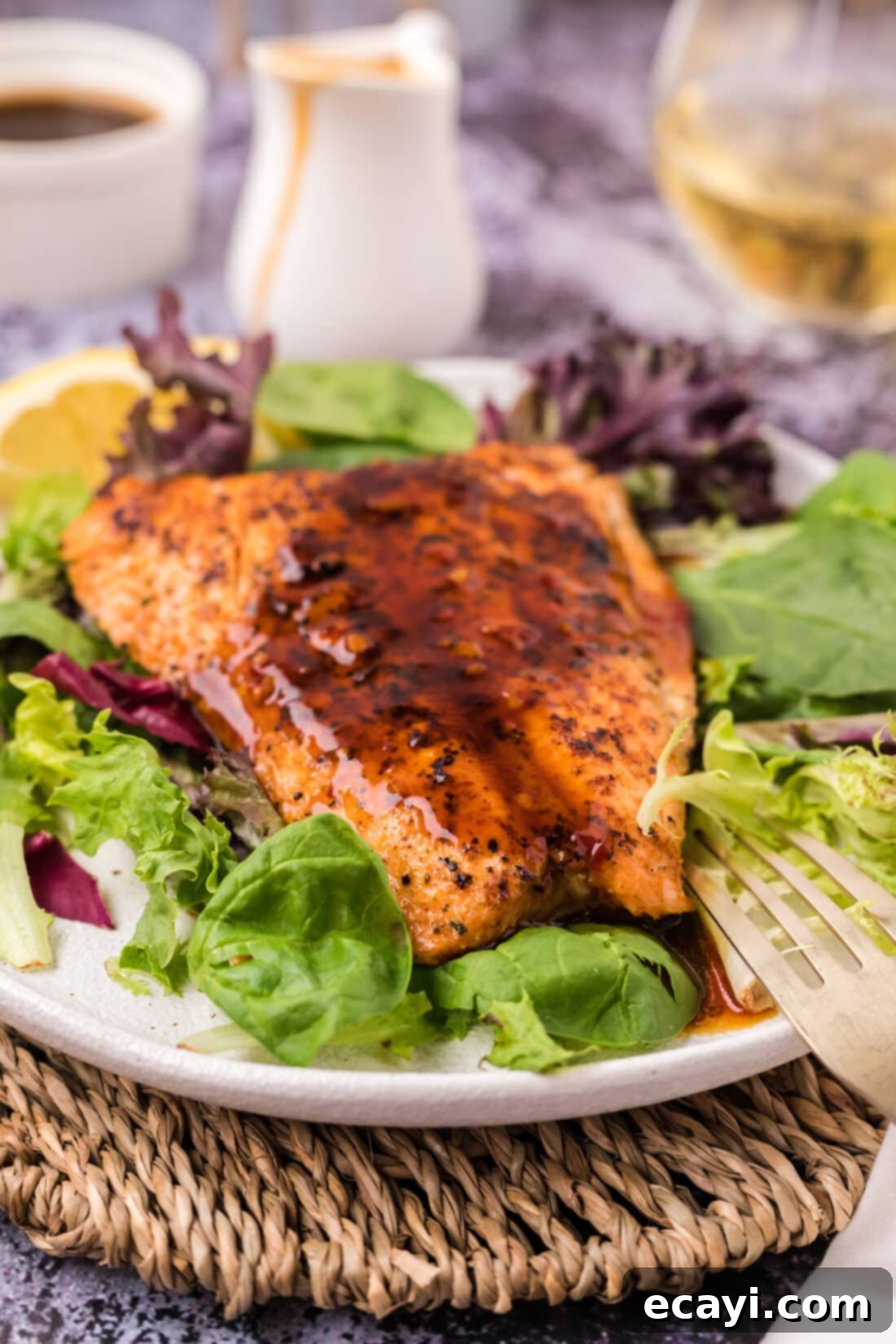
Creative & Delicious Serving Suggestions
This sweet and spicy salmon sauce is incredibly versatile, making it suitable for a variety of meals and occasions. Here are some fantastic ways to enjoy it:
- Classic Salmon Dinner: Drizzle generously over tender grilled salmon, succulent baked salmon, or delicately poached salmon. Serve alongside a bed of fluffy white or brown rice to soak up every last drop of the flavorful sauce. Steamed or roasted vegetables like broccoli, asparagus, or green beans also make excellent companions.
- Salmon Bowls: Create vibrant and healthy salmon bowls. Start with a base of quinoa, farro, or rice, add your sauced salmon, and top with fresh ingredients like avocado, cucumber, edamame, shredded carrots, and a sprinkle of sesame seeds.
- Salmon Tacos or Wraps: Elevate your taco night! Flake the cooked salmon, toss it lightly with some of the sauce, and serve in warm tortillas with shredded cabbage, a squeeze of lime, and a dollop of sriracha mayo.
- Stir-Fry Addition: Use this sauce as a base for a quick salmon stir-fry. Cook your preferred vegetables (bell peppers, snap peas, carrots) and then add cooked salmon and a generous amount of sauce for a complete meal.
- Dipping Sauce: Don’t limit it to just salmon! This sauce makes an excellent dipping sauce for spring rolls, dumplings, chicken nuggets, or even sweet potato fries.
- Marinade or Glaze: Its robust flavors make it perfect as a marinade for salmon before cooking, allowing the fish to absorb the sweet, spicy, and savory notes. Alternatively, brush it onto your salmon during the last few minutes of grilling or baking to create a beautiful, caramelized glaze.
No matter how you choose to enjoy it, this sweet and spicy salmon sauce is sure to add a burst of exciting flavor to your meal. Enjoy!
More Delicious & Related Recipes to Explore
If you loved this sweet and spicy salmon sauce, you’ll surely enjoy exploring more recipes that offer bold flavors and culinary creativity. Here are a few recommendations to expand your cooking repertoire:
- Spicy Wings: For another delicious kick, these spicy wings are perfect for appetizers or a main course.
- Blackened Salmon: If you appreciate salmon cooked with a different flavor profile, this blackened version offers a smoky, spiced crust.
- Rosemary Cream Sauce: For those moments when you prefer a rich, herb-infused cream sauce to pair with various dishes.
- Salmon Burgers: A fantastic alternative way to enjoy salmon, perfect for grilling or pan-frying.
I love to bake and cook and share my kitchen experience with all of you! Remembering to come back each day can be tough, that’s why I offer a convenient newsletter every time a new recipe posts. Simply subscribe and start receiving your free daily recipes!

Sweet & Spicy Salmon Sauce
IMPORTANT – There are often Frequently Asked Questions within the blog post that you may find helpful. Simply scroll back up to read them!
Print It
Pin It
Rate It
Save ItSaved!
Ingredients
- ¼ cup low sodium soy sauce
- 1 Tablespoon sesame oil
- 2 Tablespoons hoisin sauce
- ½ Tablespoons Asian chili sauce
- ½ Tablespoon sriracha
- 2 Tablespoons maple syrup
- ½ Tablespoon cornstarch
- ¼ cup water
Things You’ll Need
-
Medium Skillet
-
Whisk
Before You Begin
- For additional heat, try adding some crushed red pepper flakes, or a bit more Asian chili sauce/sriracha to taste.
- This recipe calls for low sodium soy sauce. If using regular soy sauce, it might be a little saltier than our version, so you might want to reduce the amount slightly.
- You can substitute the maple syrup with honey or brown sugar if desired.
- For a smooth sauce, ensure cornstarch is thoroughly whisked with cold water to form a lump-free slurry before adding to the hot sauce.
Instructions
-
In a medium skillet, combine the low sodium soy sauce, sesame oil, hoisin sauce, Asian chili sauce, sriracha, and maple syrup. Whisk well to combine all ingredients.
-
Bring the mixture to a gentle boil over medium heat, whisking occasionally to prevent sticking and ensure even heating.
-
In a separate small bowl, prepare a cornstarch slurry by whisking together the cornstarch and cold water until smooth and lump-free.
-
While the sauce is bubbling on the stove, slowly pour the cornstarch slurry into the skillet, continuously whisking to incorporate it evenly.
-
Continue to cook the sauce on medium heat for 3-4 minutes more, whisking occasionally, until it thickens to your desired consistency and achieves a glossy finish.
-
Serve immediately by drizzling generously over cooked salmon fillets, or use as a delicious dipping sauce.
Nutrition
The recipes on this blog are tested with a conventional gas oven and gas stovetop. It’s important to note that some ovens, especially as they age, can cook and bake inconsistently. Using an inexpensive oven thermometer can assure you that your oven is truly heating to the proper temperature. If you use a toaster oven or countertop oven, please keep in mind that they may not distribute heat the same as a conventional full sized oven and you may need to adjust your cooking/baking times. In the case of recipes made with a pressure cooker, air fryer, slow cooker, or other appliance, a link to the appliances we use is listed within each respective recipe. For baking recipes where measurements are given by weight, please note that results may not be the same if cups are used instead, and we can’t guarantee success with that method.
